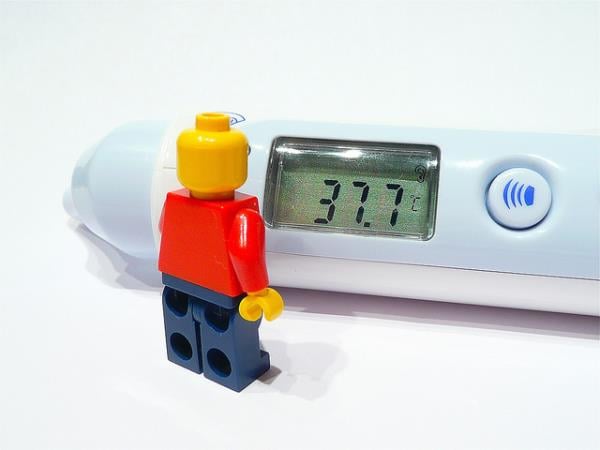
A recent study says parents often overreact to children’s fevers. And sometimes the steps parents take can actually make things worse.
Here’s what you need to know.
What is a normal temperature?
Normal temperature in children is between 36 °C and 37 °C. There could be a difference of about half a degree, depending on how you take the child’s temperature – either in the armpit, orally (under the tongue) or rectally (in the anus).
Rectal temperature readings are the most accurate but this is usually done in hospital and you don’t need to be so precise when taking a reading at home.
How should I take my child’s temperature?
The first thing any mother would do is to put her hand on her child’s forehead. While this will give you a good idea of whether your child’s temperature is higher than normal, the best way to check is with a glass thermometer or a digital one.
Be careful if you’re using a glass thermometer as children can bite it and break the glass. These thermometers contain mercury, which is poisonous. It’s better to take your child’s temperature in their armpit if you’re using a glass thermometer. The correct way to use it is to shake the mercury down and place the tip of the thermometer in the child’s armpit, making sure it’s in contact with the skin on both the arm and the chest.
Digital thermometers measure temperature quickly and are accurate and easy to use but they’re more expensive. There are two types of digital thermometers, one that can be used under the tongue or under the arm (R20 to R80 at pharmacies and Clicks stores) and the other designed for taking a child’s temperature in the ear (around R300).
Tips for taking a child’s temperature
- Don’t bundle your baby or child up too tightly before taking his or her temperature.
- Never leave your child alone while taking his or her temperature.
- If you’re taking your child’s temperature rectally, coat the tip of the thermometer with petroleum jelly (Vaseline) and insert it about a centimetre and a half into the rectum. Hold the thermometer still and do not let go. Keep it there for three to four minutes before taking a reading. If it’s a digital thermometer, wait until it beeps, then remove and check the reading.
- If you’re taking your child’s temperature orally, place the end of the thermometer under the tongue. Leave it there for three to four minutes if it’s a glass thermometer or leave it there until it beeps if it’s a digital one. Remove the thermometer and check the reading.
- Clean the thermometer when you’re done using it.
What medicine is needed to lower a fever?
The most common medicines for reducing fever in children contain paracetamol (over-the-counter medicines such as Panado and Calpol). How much you should give your child depends on his weight and age – check the bottle or package insert. You can also ask the pharmacist to recommend a medicine and ask about the correct dosage for your child.
You can also use fever-reducing suppositories – these are easier to give, especially to children who refuse to swallow medicine. Never give it in addition to oral medication.
Tips on giving medicine
- Don’t give more than five doses in a day.
- Don’t give a baby younger than three months old medicine unless your doctor tells you to.
- Always read labels carefully. Make sure you’re giving your child the right amount of medicine.
- If using drops, fill the dropper to the correct line.
What else can I do?
- Give the child plenty of fluids because a fever increases fluid loss and dehydration can raise body temperature. Even if the child doesn’t feel thirsty keep offering fluids. If she feels nauseous encourage her to take frequent sips. She could also suck ice cubes or frozen treats.
- Make sure your child gets plenty of rest. Dress your child in light cotton pyjamas so that body heat can escape. If your child gets chills, put a warm top on her and give her warm liquids. Remove it when the chills stop.
- Sponge your child down with damp cloths soaked in lukewarm water. If your child starts to shiver, stop sponging – the shivering can actually raise the fever.
- If your child is sweating and says he’s hot, allow him to take off a layer or two of clothing.
When to go to a clinic or see a doctor
- Any baby under three months with a fever should be taken to a doctor as babies this young can get very sick very quickly.
- Babies aged three to six months with a temperature of 38,3 °C should be taken to a doctor, even if they don’t seem sick.
- If your child aged six months or older has a fever of around 38,8 °C, watch how he or she acts. Go to a clinic or see your doctor if the fever goes up or lasts for more than three days.
- If your child has a fever of 39 °C or higher, take her to the clinic or doctor even if she seems fine.
- If your child becomes drowsy or slow, complains of headaches or neck stiffness, vomits, refuses to take liquids, develops a rash or becomes sensitive to light see a doctor immediately.
Remember: Fever is the body’s way of fighting infection. It’s absolutely normal and a sign that your child’s body is battling a virus or some other infection. That’s not to say you should ignore it – it’s a way of determining how sick a child is. But there’s no reason to panic too early.
BY SIBA SEGALE




 Publications
Publications
 Partners
Partners
















